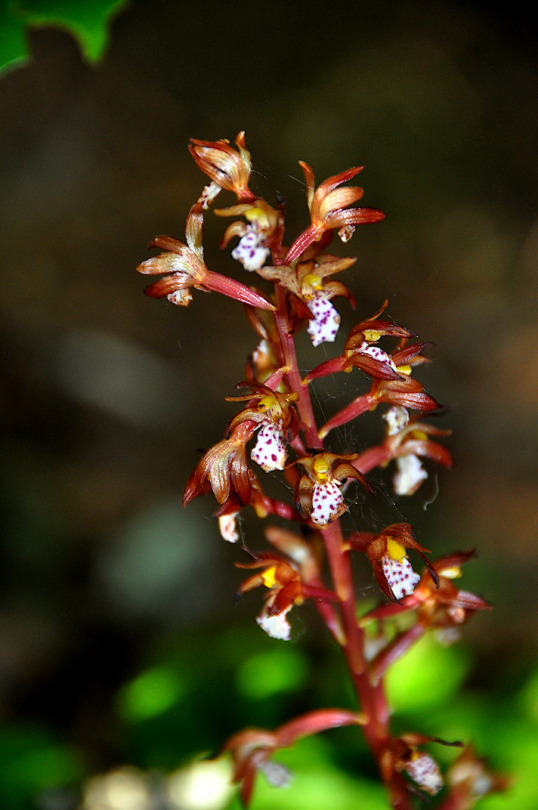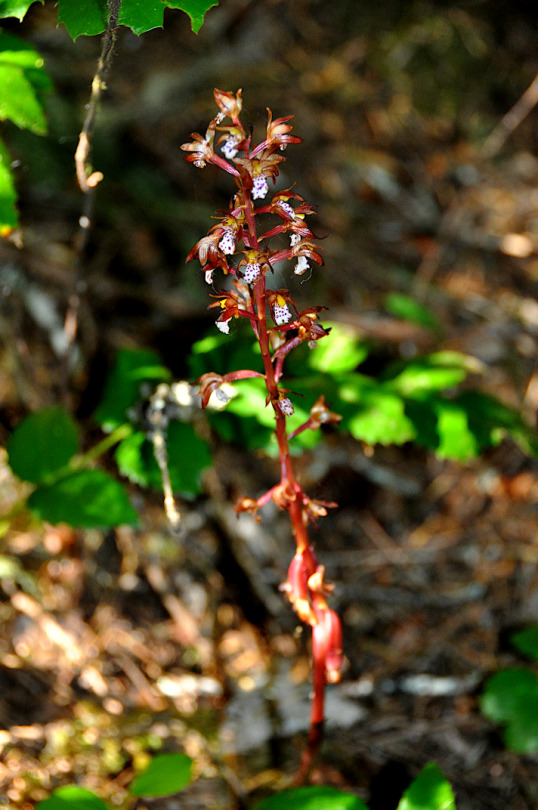#spotted coralroot
Text
JUST ONE: Coralroots

View On WordPress
0 notes
Photo

Western Spotted Coralroot orchid

#plant#native#flower#Western Spotted Coralroot orchid#the Woods#photozoi#6-10-23#original photos#7pm so the flowers point downward
16 notes
·
View notes
Text



Spotted coralroot
#orchid#flower#forest#nature#beauty#photographers on tumblr#artists on tumblr#original photographers#original photography#photography#aesthetic#Washington#pnw#westcoastbestcoast#art#vsco#pacific northwest#explore#travel#cottagecore#naturecore#grandmacore#p
59 notes
·
View notes
Audio
On Going Unnoticed -- Robert Frost
As vain to raise a voice as a sigh
In the tumult of free leaves on high.
What are you, in the shadow of trees
Engaged up there with the light and breeze?
Less than the coralroot, you know,
That is content with the daylight low,
And has no leaves at all of its own;
Whose spotted flowers hang meanly down.
You grasp the bark by a rugged pleat,
And look up small from the forest's feet.
The only leaf it drops goes wide,
Your name not written on either side.
You linger your little hour and are gone,
And still the woods sweep leafily on,
Not even missing the coralroot flower
You took as a trophy of the hour.
0 notes
Text


Spotted coralroot orchid!
#nature#mountains#hiking#landscape#new mexico#forest#orchid#wild orchid#spotted coralroot#flower#wildflowers
10 notes
·
View notes
Photo

Spotted coralroot, Corallorhiza maculata, Olympia, WA
#orchid#wildflowers#wild orchid#my photo#coralroot#achlorophyllous#parasitic plants#spotted coralroot#flower#flowers#spring#<3
7 notes
·
View notes
Photo


One of the stranger orchids that grows Washington State is spotted coralroot, Corallorhiza maculata. This is a parasitic orchid, a myco-heterotroph that doesn’t have any chlorophyll or use photosynthesis, instead getting all of its nutrients from the underground mycelia of russula and milk-cap mushrooms in the family Russulaceae. It’s helpful for predicting where to find russulas and milk-caps in the fall! I found this one near Issaquah, WA.
26 notes
·
View notes
Photo

Corallorhiza maculata summer coralroot, Willamette National Forest, Oregon USA
#Corallorhiza maculata#spotted coralroot#botany#Willamette National Forest#oregon#photographers on tumblr
10 notes
·
View notes
Photo


a parasitic orchid from the forest
Spotted Coralroot (Corallorhiza maculata)
30 notes
·
View notes
Text
While that’s just horrible, you, you…
*pulls out wildflower identification booklet*
You tansy ragwort. You nodding onion! You absolute tufted vetch! You’re just a no-good pinesap, a terrible blue stickseed! I bet your own family hates you, you good-for-nothing gumweed! You hear that? You’re just a common snowberry! I never should have spoken to you, the one-sided wintergreen you are! You hedge-nettle, the absolute nerve of you!
You long-bracted frog orchid, you spotted coralroot, you mountain ladysipper, you twayblade, you sulphur buckwheat, you tufted loosestrife, you upland larkspur, you shrubby cinquefoil, the worst baneberry of them all! You haunt my dreams with your hawthorn ways, you partridge foot! Don’t be a bitter cherry. Stop being a bald hip rose. Your red-stemmed saxifrage, chickweed monkey-flower, great mullein behind needs to be kicked right out of here! You’re such a showy milkweed, bunchberry! I never want to see your green false hellebore face ever again! So leave me alone, you trumpet honeysuckle!
7 notes
·
View notes
Photo


Let’s! Talk! About! Coralroot!
I am VERY excited to share these photos. I took them in late April and early May (I believe these are two different individual plants, but I’m not 100% sure).
So, these are probably Corallorhiza maculata, which has several common names, some of which are also used do describe similar species. I’ve been calling it Spotted Coralroot, since that’s the most common of the common names I’ve found. These might be Wister’s Coralroot (Corallorhiza wisteriana)...? it’s a species found in this state, but seems to be absent from the states most closely bordering this particular region.
Coralroots are orchids which is SO COOL because we just have these WILD ORCHIDS in our woods! And even cooler is that these bad boys lack the chlorophyll required for photosynthesis, so they get their nutrients from fungi instead of the sun. The photos up there are of solitary plants, but we have clusters of them as well! Here’s what they look like at an earlier stage of life:

If there are any Coralroot specialists out there, hmu. Teach me everything. I love these plants so much.
12 notes
·
View notes
Photo

Spotted Coralroot, Corallorhiza maculata (Orchidaceae). #orchid #spottedcoralroot #coralroot #corallorhizamaculata #plants #flowers #botany #plantid #plantidentification (at Leavenworth, Washington) https://www.instagram.com/p/ByjoSSYAlF4/?igshid=1xfza8mjixv8n
#orchid#spottedcoralroot#coralroot#corallorhizamaculata#plants#flowers#botany#plantid#plantidentification
40 notes
·
View notes
Photo

(via Spotted coralroot - Canada Postage Stamp | Flowers)
#Spotted coralroot#Flower stamps#flora stamps#2006 stamps#Canada Post#lcstamps#Canada Stamps#postage stamps
0 notes
Text


Spotted coralroot orchid
#orchid#flower#forest#nature#beauty#photographers on tumblr#artists on tumblr#original photographers#original photography#photography#aesthetic#Washington#pnw#westcoastbestcoast#art#vsco#pacific northwest#explore#travel#cottagecore#naturecore#grandmacore#p
73 notes
·
View notes
Video
From the archives
Via Flickr:
Spotted Coralroot (Corallorhiza maculata) at Sheppard's Dell State Park
#Columbia River Gorge#Corallorhiza maculata#Coralroot#Orchid#Plant#Sheppard's Dell State Park#Spotted Coralroot#Multnomah County#Washington
0 notes
Photo

Did you know that the Orchid family is among the most diverse plant families in the world? Second only to the Aster family, it contains more than 28,000 species, 24 of which can be found in Glacier National Park. None are abundant, however, so it can be exciting when you spot some, like this patch of striped coralroot (Corallorhiza striata). Have you had any surprising discoveries of hidden "treasures" on a recent visit to the park?
19 notes
·
View notes
